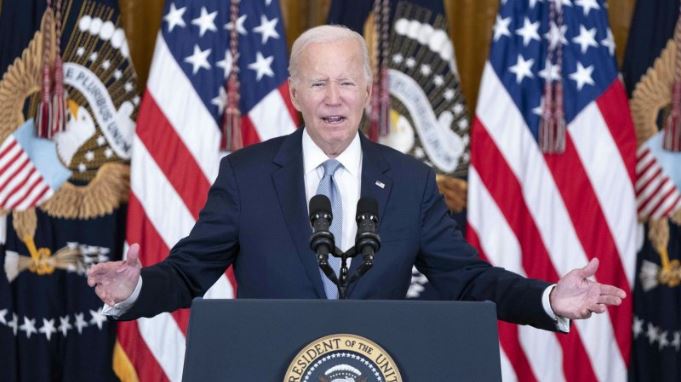
Aug. 29 (UPI) — The Biden administration on Tuesday announced the initial slate of 10 prescription medicines chosen as part of the first-ever pricing negotiations between Medicare and the nation’s pharmaceutical giants.
The Medicare Drug Price Negotiation Program guide — released by the Centers for Medicare & Medicaid Services — comes as President Joe Biden seeks to fulfill a campaign promise to make prescription drugs more affordable for millions of aging Americans.
The drugs on the list “are among the most common and costly prescriptions that treat everything from heart failure, blood clots, diabetes, arthritis, Crohn’s disease — and more,” Biden said in a statement announcing the start of the highly anticipated program.
“When implemented, prices on negotiated drugs will decrease for up to 9 million seniors,” Biden said, echoing his previous vows to lower prescription drug costs. “These seniors currently pay up to $6,497 in out-of-pocket costs per year for these prescriptions. In addition, the nonpartisan Congressional Budget Office reports that this will save taxpayers $160 billion by reducing how much Medicare pays for drugs through negotiation and inflation rebates.”
Biden’s program is being funded by the Inflation Reduction Act of 2022, which expanded Medicare’s authority to negotiate out-of-pocket drug costs, including a $2 monthly cap on certain generic drugs used to treat chronic conditions, as well as a $35 price cap on insulin.
When the pricing negotiations wrap up, the new drug prices won’t go into effect until 2026 — more than 28 months from now.
The 10 drugs under consideration in the first round of talks are among the top 50 prescription medications that seniors fill the most at retail pharmacies under Medicare Part D, the White House said.
They are:
- Eliquis, from Bristol-Myers Squibb, to prevent blood clotting and reduce stroke risk
- Jardiance, from Boehringer Ingelheim, to lower blood sugar for people with type 2 diabetes
- Xarelto, from Johnson & Johnson, to prevent blood clotting and reduce stroke risk
- Januvia, from Merck, to lower blood sugar for people with type 2 diabetes
- Farxiga, from AstraZeneca, to treat type 2 diabetes
- Entresto, from Novartis, to treat heart failure
- Enbrel, from Amgen, to treat rheumatoid arthritis
- Imbruvica, from Abbvie, to treat various types of blood cancers
- Stelara, from Janssen, to treat Crohn’s disease
- A family of insulin products made by Novo Nordisk to treat diabetes, including Fiasp; Fiasp FlexTouch; Fiasp PenFill; NovoLog; NovoLog FlexPen; and NovoLog PenFill.
In 2022, Medicare Part D enrollees paid a total of $3.4 billion in out-of-pocket costs for the listed drugs, with the average person paying as much as $6,497 on prescriptions throughout the year, the White House said.
Drug manufacturers have criticized Biden’s plan as detrimental to profits and innovation, while Merck and Johnson & Johnson have filed multiple lawsuits in an effort to declare the plan unconstitutional.
Biden said his plan was working to make a difference for struggling Americans while the pharmaceutical industry continued to rake in record profits.
“Let me be clear: I am not backing down,” Biden said. “There is no reason why Americans should be forced to pay more than any developed nation for life-saving prescriptions just to pad Big Pharma’s pockets.”
Biden’s plan has also drawn criticism for adding commercial health insurers to a requirement that forces drug companies to pay rebates to Medicare whenever medicine prices rise faster than inflation.
Rebates for drugs administered by physicians under Medicare Part B went into effect on Jan. 1.
In March, the U.S. Department of Health and Human Services announced the first set of prescription drugs that would be subject to the rebates, bringing a lower co-pay to about 27 prescription drugs that saw prices rise sharply in the final quarter of 2022.
By comparison, 1,200 prescription drugs increased their prices faster than inflation throughout 2021 before Biden’s policies went into effect.
Biden’s plan also allows for free vaccines for Medicare recipients and decreases costs for behavioral and mental health services.
Beginning in 2024, Part D enrollees will no longer pay a 5% co-pay after the maximum benefit is reached, while the out-of-pocket cap drops to $2,000 in 2025, and 1.9 million enrollees with the highest drug costs will save an average of $2,500 per year, the White House said.
Medicare recipients will continue to see their prescription drug costs go down as more provisions of the Inflation Reduction Act go into effect in the coming years, the White House said.
Biden’s federal budget proposal for 2024 calls for extending Medicare and Social Security and reducing the deficit by raising taxes on wealthy Americans.
The reforms would increase the Medicare tax rate from 3.8% to 5% on those who earn more than $400,000 per year, which would keep Medicare solvent for the next 25 years, the White House said previously.






